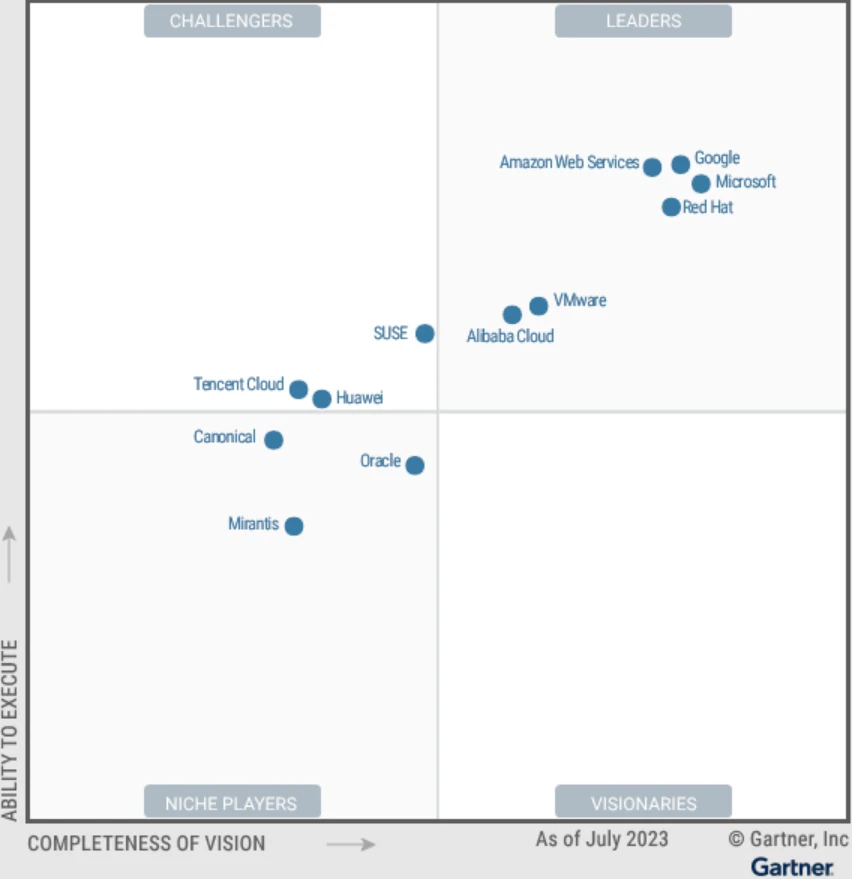Cloud-native technologies like containers and Kubernetes are the future of application development. That’s why we’re honored to announce that Microsoft has been named a Leader in the 2023 Gartner® Magic Quadrant™ for Container Management*. We believe that this recognition validates our end-to-end approach for developing and deploying enterprise-grade, cloud-native apps that run on Azure, in datacenters, or at the edge.

Gartner recognition of Microsoft as a Leader in this Magic Quadrant, we feel, highlights the broad and deep integration of Azure Kubernetes Service (AKS) with other Azure services. Customers tell us that using AKS for container management helps them modernize existing apps in stages, as time and budget permit, and creates a roadmap for new, cloud-native development that takes advantage of Azure scale, security, performance, and cost optimization. Developers rely on autoscaling AKS clusters to meet the most challenging performance demands, while fully managed Azure services free teams from time-consuming infrastructure management tasks.

Innovate, deploy, and operate Kubernetes seamlessly
Deploy and scale containers on managed Kubernetes
Customers have diverse environments and they want to run containers anywhere. Our customers run AKS on Azure and in hybrid configurations, using Azure Stack HCI on-premises and Azure Arc to manage it all.
Read the full report to learn more about why Microsoft was named a Leader for container management.
Scaling up means skilling up
Recently, we presented at KubeCon North America 2023 and at Microsoft Ignite, where we introduced Microsoft Copilot for Azure (in preview). This AI-powered assistant makes it easy for developers to get the answers they need and to work more efficiently, including AKS.
Many developers at the conferences told us that the integration support in AKS makes adoption easier as their organizations roll out ambitious digital transformation projects. Even though Kubernetes is designed to manage the complexity of many moving parts, that complexity has a learning curve. Container-related expertise is still limited, as the Gartner report points out.
“As Kubernetes continues to become pervasive, a lot of teams find themselves at different steps of their adoption, skill set, or learning stage”
AKS Principal PM Lead Jorge Palma recently posted. Gartner even cautions enterprises against deploying container management “without deep knowledge of developer requirements.”
Tools like Copilot for Azure help developers do more with Azure and AKS. Microsoft offers many additional resources to help developers—no matter where they are in the adoption cycle. Here are just a few ideas:
- If you’re at the blank page stage, get real-world examples and solution ideas from our solution architectures.
- Explore Kubernetes solutions and services in Azure Marketplace, where you can find click-through deployments to the Kubernetes platform and flexible billing models.
- To get inspired, read how the development team behind Forza Horizon 5 converted services to AKS in about a month—without any prior Kubernetes experience—fueling the biggest first week in Xbox Games Studio history.
- To boost skills, consider one of the professional learning paths provided by Microsoft Learn, such as Introduction to Kubernetes on Azure or Administer containers in Azure.
- To stay on top of your deployment, review these developer best practices.
Powering the AI revolution with AKS
Generative AI continues to rocket across the landscape—and it’s often built on top of Kubernetes. Cloud-native and AI are working together to fuel innovation at scale, and AKS is part of this revolution of intelligent apps. Developers can build apps in AKS that consume Azure OpenAI Service as part of the architecture.
AI applications often come with bigger container images, so AKS recently added artifact streaming. Container images can be streamed directly to the nodes where they’re running a high-performance, on-demand protocol. That means pods are scheduled faster and start running more quickly.
AI applications also push the limits of scale, making cost management a top priority. Microsoft recently announced that teams can get more visibility and transparency into cluster costs right in the Azure portal. The cost analysis add-on for AKS (in preview) uses OpenCost to break down underlying cluster infrastructure costs into specific Kubernetes units, such as cluster and namespace.
In addition, organizations can run specialized machine learning workloads, like large language models (LLMs), on AKS more cost effectively and with less manual configuration. The new AI toolchain operator, a managed add-on based on Kaito, simplifies the process of hosting and distributing open-source AI models and customized inferencing on AKS clusters. Another option for improving cluster efficiency and costs is to use the new open-source provider for running Karpenter on AKS.
Microsoft also recently announced support for Kubernetes fleets, enabling platform administrators to manage multiple AKS clusters at scale. Azure Kubernetes Fleet Manager addresses the challenge of staging updates across clusters in a safe and predictable way.
DevOps makes the wheels go round
As the Gartner report explains, “the combination of DevOps and container technology can be a powerful enabler for application development agility and speed, making DevOps skills the critical factor to deployment success.” DevOps drives quality and promotes consistency with provisioning and management practices, including continuous integration and continuous deployment (CI/CD).
Yet building distributed applications can still be a complex business, which is why the AKS team continues to look for ways to help streamline this process. For example, Draft for AKS (in preview) helps streamline Kubernetes deployment, and new smart defaults speed up cluster configuration. In June 2023, we added Distributed Application Runtime (Dapr) APIs that help developers write and implement simple, portable, resilient, and secured microservices. To automate builds and deploy them to AKS clusters, Azure Pipelines provides CI/CD.
Developers using Azure Container Apps will find it even easier to deploy code to the cloud and to run AI workloads. New “code-to-cloud” integrated cloud build productivity helps any developer build and run their apps on Azure Container Apps—no container knowledge required. In addition, the recently released landing zone accelerator provides a valuable reference for builders of cloud-native apps and microservices. And for compute-heavy workloads, like model training and batch inferencing, dedicated GPU workload profiles (in preview) provide the power.
Protecting everything
According to Gartner, by 2026, the adoption of CSP-native platforms will propel 75% of container instances to be deployed within public cloud environments, up from 50% in 2023. At KubeCon and Ignite, we heard IT, ops, and cybersecurity experts from around the world share their approach to security in the cloud. At Microsoft, we’re committed to providing our customers with the tools and resources they need to protect everything. For containers, that means security measures all along the pipeline—from development to runtime—and across hybrid and multicloud deployments.
At Ignite 2023, we announced that new multicloud container security is coming soon to Microsoft Defender for Cloud. Defender cloud security posture management (CSPM) will extend its advanced agentless scanning, data-aware security posture, cloud security graph, and attack path analysis capabilities to Google Cloud Platform (GCP), providing a single contextual view of cloud risks across Amazon Web Services (AWS), Azure, GCP, and hybrid environments.
Security admins will also have better visibility into the state of containerized applications so they can prioritize misconfigurations and exposures in their deployments of Amazon Elastic Kubernetes Service and Google Kubernetes Engine clusters.
The AKS documentation explains more security concepts for applications and clusters, and the Microsoft Security blog offers expert coverage on security matters.
Learn more
*Gartner is a registered trademark and service mark and Magic Quadrant is a registered trademark of Gartner, Inc. and/or its affiliates in the U.S. and internationally and are used herein with permission. All rights reserved.
This graphic was published by Gartner, Inc. as part of a larger research document and should be evaluated in the context of the entire document. The Gartner document is available upon request here.
Gartner does not endorse any vendor, product, or service depicted in its research publications, and does not advise technology users to select only those vendors with the highest ratings or other designation. Gartner research publications consist of the opinions of Gartner’s research organization and should not be construed as statements of fact. Gartner disclaims all warranties, expressed or implied, with respect to this research, including any warranties of merchantability or fitness for a particular purpose.
Gartner, Magic Quadrant for Container Management, By Dennis Smith, Wataru Katsurashima, Michael Warrilow, Tony Iams, Richard Watson, 20 September 2023.




